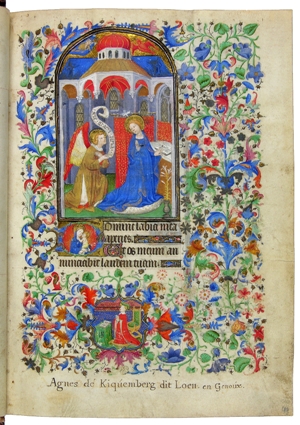Related Research Articles

Anglicanism is a Western Christian tradition that has developed from the practices, liturgy, and identity of the Church of England following the English Reformation, in the context of the Protestant Reformation in Europe. It is one of the largest branches of Christianity, with around 110 million adherents worldwide as of 2001.

Benedict of Nursia was an Italian Christian monk, writer, and theologian who is venerated in the Catholic Church, the Eastern Orthodox Church, the Oriental Orthodox Churches, the Anglican Communion, and Old Catholic Churches. He is a patron saint of Europe.

The Benedictines, officially the Order of Saint Benedict, are a monastic religious order of the Catholic Church following the Rule of Saint Benedict. They are also sometimes called the Black Monks, in reference to the colour of their religious habits. They were founded by Benedict of Nursia, a 6th-century monk who laid the foundations of Benedictine monasticism through the formulation of his Rule of Saint Benedict.

Pope Gregory I, commonly known as Saint Gregory the Great, was the bishop of Rome from 3 September 590 to his death. He is known for instigating the first recorded large-scale mission from Rome, the Gregorian mission, to convert the then largely pagan Anglo-Saxons to Christianity. Gregory is also well known for his writings, which were more prolific than those of any of his predecessors as pope. The epithet Saint Gregory the Dialogist has been attached to him in Eastern Christianity because of his Dialogues. English translations of Eastern texts sometimes list him as Gregory "Dialogos", or the Anglo-Latinate equivalent "Dialogus".
A religious order is a lineage of communities and organizations of people who live in some way set apart from society in accordance with their specific religious devotion, usually characterized by the principles of its founder's religious practice. It is usually composed of laypeople and, in some orders, clergy. Such orders exist in many of the world's religions.

In the practice of Christianity, canonical hours mark the divisions of the day in terms of fixed times of prayer at regular intervals. A book of hours, chiefly a breviary, normally contains a version of, or selection from, such prayers.

A monk is a person who practices religious asceticism by monastic living, either alone or with any number of other monks. A monk may be a person who decides to dedicate their life to serving other people and serving God, or to be an ascetic who voluntarily chooses to leave mainstream society and live their life in prayer and contemplation. The concept is ancient and can be seen in many religions and in philosophy.

Christian monasticism is the devotional practice of Christians who live ascetic and typically cloistered lives that are dedicated to Christian worship. It began to develop early in the history of the Christian Church, modeled upon scriptural examples and ideals, including those in the Old Testament, but not mandated as an institution in the scriptures. It has come to be regulated by religious rules and, in modern times, the Canon law of the respective Christian denominations that have forms of monastic living. Those living the monastic life are known by the generic terms monks (men) and nuns (women). The word monk originated from the Greek μοναχός, itself from μόνος meaning 'alone'.

Compline, also known as Complin, Night Prayer, or the Prayers at the End of the Day, is the final prayer liturgy of the day in the Christian tradition of canonical hours, which are prayed at fixed prayer times.

The Order of Canons Regular of Prémontré, also known as the Premonstratensians, the Norbertines and, in Britain and Ireland, as the White Canons, is a religious order of canons regular of the Catholic Church founded in Prémontré near Laon in 1120 by Norbert of Xanten, who later became Archbishop of Magdeburg. Premonstratensians are designated by OPraem following their name.

Christian liturgy is a pattern for worship used by a Christian congregation or denomination on a regular basis. The term liturgy comes from Greek and means "public work".
In Christianity, an oblate is a person who is specifically dedicated to God and to God's service.

The Abbey of Our Lady, Help of Christians, commonly known as Worth Abbey, is a community of Roman Catholic monks who follow the Rule of St Benedict near Turners Hill village, in West Sussex, England. Founded in 1933, the abbey is part of the English Benedictine Congregation. As of 2020, the monastic community had 21 monks.

The Discalced Carmelites, known officially as the Order of the Discalced Brothers of the Blessed Virgin Mary of Mount Carmel or the Order of Discalced Carmelites, is a Catholic mendicant order with roots in the eremitic tradition of the Desert Fathers and Mothers. The order was established in the 16th century, pursuant to the reform of the Carmelite Order by two Spanish saints, Saint Teresa of Ávila (foundress) and Saint John of the Cross (co-founder). Discalced is derived from Latin, meaning "without shoes".

Anglican religious orders are communities of men or women in the Anglican Communion who live under a common rule of life. The members of religious orders take vows which often include the traditional monastic vows of poverty, chastity and obedience, or the ancient vow of stability, or sometimes a modern interpretation of some or all of these vows. Members may be laity or clergy, but most commonly include a mixture of both. They lead a common life of work and prayer, sometimes on a single site, sometimes spread over multiple locations.
The Brotherhood of Saint Gregory is a community of friars within the Anglican Communion. The community's members, known as Gregorians, include clergy and laymen. Since 1987 there has also been a parallel order of sisters, the Sisters of Saint Gregory.
Lex orandi, lex credendi, sometimes expanded as Lex orandi, lex credendi, lex vivendi, is a motto in Christian tradition, which means that prayer and belief are integral to each other and that liturgy is not distinct from theology. It refers to the relationship between worship and belief. As an ancient Christian principle it provided a measure for developing the ancient Christian creeds, the canon of scripture, and other doctrinal matters. It is based on the prayer texts of the Church, that is, the Church's liturgy. In the Early Church, there was liturgical tradition before there was a common creed, and before there was an officially sanctioned biblical canon. These liturgical traditions provided the theological framework for establishing the creeds and canon.

St. Gregory's Abbey is an American monastic community of men living under the Rule of St. Benedict within the Episcopal Church. The abbey is located near Three Rivers in St. Joseph County, Michigan.

Western Rite Orthodoxy, also called Western Orthodoxy or the Orthodox Western Rite, are congregations within the Eastern Orthodox tradition which perform their liturgy in Western forms.

St Patrick's Church is an Anglican church in Hove, in the English city of Brighton and Hove. Situated on a narrow site at 3 Cambridge Road, off Western Road close to the boundary with Brighton, it is still in use as a place of worship. Since 1985 St Pat's developed a special ministry with homeless people, setting up a night shelter and a homeless hostel. In 2012, St Patrick's night shelter was closed. The homeless hostel continues to operate under new management, and is currently run by Riverside Housing Association. The church closed as a parish in 2015, and was then entrusted by the Bishop of Chichester to the Chemin Neuf Community under a Bishop's Mission Order. The leader of the Chemin Neuf Mission at St Patrick's is currently the Revd Tim Watson.
References
- ↑ Anglican orders "CSWG". Archived from the original on 26 October 2012. Retrieved 30 July 2012.
- ↑ Crawley Down village website "Archived copy". Archived from the original on 7 May 2012. Retrieved 30 July 2012.
{{cite web}}: CS1 maint: archived copy as title (link)
Coordinates: 51°08′04″N0°04′38″W / 51.134358°N 0.077266°W